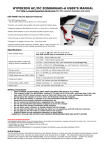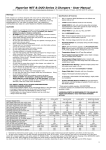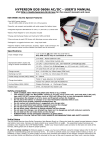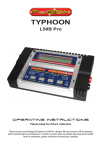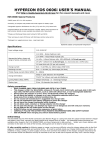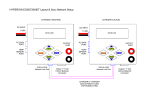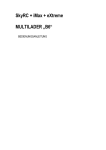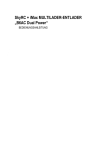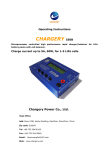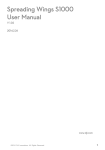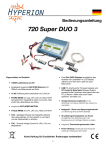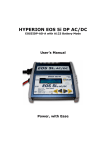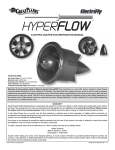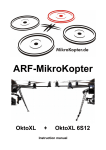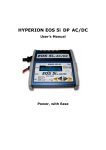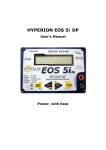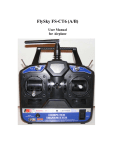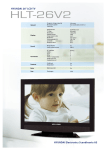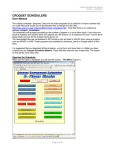Download User Manual
Transcript
HYPERION AC/DC EOS0606iAD-C USER’S MANUAL Visit http://media.hyperion.hk/dn/eos for the newest manuals and news EOS 0606i AC/DC Special Features (rev “C”) *Use AC 100V~240V at home OR DC 11V~15V anywhere *Powerful, yet compact and portable with wide support for battery types *Integrated Hyperion LBA Balancer for LiPo (3.7v) and LiFe (3.3v) based cells *Balance Multi-Adapters for 2S~6S packs inc. (Hyperion and XH Types) *Charge, Discharge, and STORAGE Modes (and Cycling for NiMh and NiCd) *Clear Yellow Backlit LCD Screen, Warnings for common setup errors *Packaged in a rugged case, with Long Input leads *Option multi-connectors for common pack brands are also available (see details end of document) Specifications Input voltage range 11.0-15.0V DC OR 100~240V AC at 50~60 Hz Only ONE source may be connected at a time! 1-14 NiCd – Nickel-Cadmium cells Appropriate battery types and range of series-connected cells 1-14 NiMH – Nickel-Metal Hydride cells 1-6 LiPo – Lithium Polymer cells, 100~20,000mAh (3.7V/cell type only) 1-6 LiFe – Lithium Iron (3.3V/cell types, inc. A123 brand cells / LiFePO4 cells) 1-6 Lead-Acid cells (2V per cell nominal) Charge current 0.1A ~ 6.0A MAX, by 50mA steps for Lipo and LiFePO4 / 100mA steps for NiCdd, NiMH and Lead-Acid (50W limit) Discharge current 0.1A ~ 1.0A MAX, by 10mA steps (5W limit) Trickle charge current (NiCd, NiMH) 0 ~ 200mA Charge termination “Delta V” peak detection for NiCd/NiMH “CV/CC” for Lithium and Lead-Acid Batteries Cycling Modes (NiCd, NiMH) Charge>Discharge Display type 2-line, 16 character high-visibility yellow backlit LCD or Discharge>Charge Safety precautions • • • • • • • • • • • • KEEP CHARGER and BATTERIES AWAY FROM CHILDREN AND PETS AT ALL TIMES! This charger is ONLY for NiCd/NiMH, Lithium (3.7V/cell), A123 (3.3V/cell), and Lead-Acid (2.0V/cell) type cells. DO NOT connect others, such as 3.6V/cell Lithium-Ion, or non-rechargeable batteries! Always place the charger on a firm, level, and fireproof surface for charging Do not place the battery or charger on or near flammable materials while in use: Keep away from carpets, cluttered workbenches, etc Do not exceed cell manufacturer’s suggested max charge rates Do not use automotive type battery chargers to power the charger Do not leave the charger unattended while charging Do not allow water, moisture or foreign objects into the charger Do not open the charger, nor attempt any repair as it is dangerous and will void your warranty Do not obstruct the air intake or outlet holes on the charger ALWAYS follow correct connection sequence, as given below CAREFULLY FOLLOW THE BATTERY PACK MAKER’S RECOMMENDATIONS AND SAFETY ADVICE! HIGH RISK CHARGING ADVISORY Avoid charging batteries indoors. If you must charge indoors – or any place injury to persons or damage could result in the event of fire – then be sure to: * Keep battery well away from flammables (2 meters or more) * Contain battery in a heavy fireproof container (such as a brick box) * Always monitor the charge HYPERION ACCEPTS NO RESPONSIBILITY FOR DAMAGE OR INJURY during INDOOR or other HIGH RISK CHARGING ACTIVITY Initial Setup The EOS 0606i requires 4mm Bullet Connectors (aka Banana Plugs) on 12awg wire leads for output harness between charger and battery main wires. Harness wire leads should never exceed 20cm in length. Pre-assembled output harnesses are available under Hyperion Part #HP-EOSOUTCORD, and one harness is included with each charger. Solder your chosen battery-side connector to the bare wire ends of the harness, taking great care to observe proper polarity. If, after carefully reading the following pages on usage, you have any difficulty using the charger please refer to the final pages for troubleshooting guide and warranty terms. It is well to carefully check your charger before making a return, as problems in setup, cabling, or power supply are much more common than defects in the charger. Chargers returned by the user and later found not defective will only be returned to the user at the user’s expense and may incur a service charge. ALWAYS FOLLOW this connection sequence, and reverse sequence to disconnect: 1) Connect OUTPUT harness 4mm plugs to the sockets located on the right side of the charger. Take care that the Output Harness RED wire bullet connector goes to the (+) socket, and BLACK wire to (-) . 2a) Connect Charger INPUT alligator clips to an appropriate DC power source: a) A 12V automobile battery b) A quality, low-noise DC power supply of 12~15V with 5A+ rating (large batteries may require 10A supply) OR 2b) Connect to AC wall power 100~240V using the supplied AC cable DO NOT CONNECT BOTH AC AND DC INPUT AT THE SAME TIME!! The Charger will display INPUT VOLTAGE error message if input voltage is out of range. If this happens, please recheck the input power supply to make sure correct voltage of 11V to 15V is present. 3) Set the battery type using the charger configuration buttons. *The INC and DEC buttons are used to Increase or Decrease values, such as Charge Current or Cell Count *The INC and DEC buttons are also used to select MODE, such as Charge, Discharge, Store, or Cycle. *The BATT TYPE and ENTER buttons both have two modes: SHORT press or LONG (~1 second) press • Short press BATT TYPE: Scroll battery types (NiCd > NiMH > LiPo > LiFe > Pb) • Long press BATT TYPE: View input/output Data • Short press ENTER: Scroll settings for a battery type. Values will blink when selected. Blinking will stop after a few seconds if you do not make a change. Short press Enter to re-select a setting to change. Short press BATT TYPE to re-select Battery Type, then INC/DEC to change values. • Long press ENTER: START/STOP charging (or discharging, or cycling, etc) Let’s start by using a NiMh battery as an example. When the charger is first connected to input power, it will display the previously used battery configuration. convenient if you often charge the same type of battery. This is especially 1) If NiMh is not shown, short push the BATT TYPE button to scroll through all battery types. Stop when you reach NiMh. 2) Short press the ENTER button to select “C”, charge rate in Ampere 3) Press INC or DEC buttons to choose the proper rate for your battery pack. Charging NiCd and NiMH is mostly automatic, and the setup routines are the same for both. You only need to consult the documentation for your battery pack (or ask your dealer) to determine the proper charge current in Ampere (A). If the rate is given in mA, note that 100mA equals 0.1A: so 900mA would be 0.9A, for example. 4) Attach your NiMH battery to the EOS 0606i Output side harness, checking that +/- polarity is correct. 5) LONG press the ENTER button (hold down for about 1~2 seconds) to begin charging NO BATTERY error – if battery not connected OPEN CIRCUIT error – if the battery becomes disconnected from the charger after START REVERSE POLARITY error – if the battery is connected in reverse 0 In our NiMH charging example above, we pressed the ENTER button when “NiMH” was blinking, to go directly to charge rate setting. However, if you want to enter DISCHARGE or CYCLE modes, you can press the BATT TYPE button to start NiMH blinking, then press INC/DEC buttons to scroll through the various modes. Once the mode is settled (like CYCLE), short press ENTER to start values blinking for editing. Lithium Care Whenever Lithium battery charging is started with Balancer properly connected, the display will show: BALANCER CONN. CONNECTED. If you see instead BALANCER CONN. NOT CONNECTED, stop and check your connections carefully, and repair or replace if needed. We strongly recommend balance charging for LiPo and LiFe packs at all times. To maximize your investment in Lithium Battery packs, do the following: • ALWAYS Store your packs at 55~65% of capacity. After a day of flying, use STORE Mode to achieve this. harmful to store lithium packs fully charged, and should be avoided for more than a week at most. • AVOID discharging cells beyond 90% of capacity. NEVER fully discharge lithium packs. • KEEP your packs in a cool, dry location whenever in storage. It is especially Note: The EOS0606i does not support charging of legacy 3.6v Lithium Ion cell types. Never attempt to charge these cells, under any circumstances, using this charger. LITHIUM POLYMER/ION MODE (for 3.7V/cell types only!) Number of LiPo Cells Wired in Series (Pack Voltage) 1S 3.7V BATT TYPE LiPo CHARGE C=3300mAh INC 6S 2S 7.4V 3S 11.1V LiPo DISCHARGE D=1.00 A 6S 4S 14.8V INC DEC 5S 18.5V LiPo STORE C= 3300mAh 6S 22.2V INC 6S DEC LiPo BALANCE 6S ①0.00②0.00③0.00V DEC ENTER ENTER INC LiPo CHARGE C=3300mAh INC INC INC DEC 6S LiPo DISCHARGE D=1.00A 6S LiPo STORE C= 3300mAh 6S ENTER ENTER DEC ENTER DEC LiPo CHARGE C=3300mAh DEC INC X.XA 6S INC DEC DEC ENTER LiPo CHARGE C=3300mAh ENTER INC DEC LiPo DISCHARGE D=1.00A 6S LiPo STORE C= 3300mAh 6S START START BATTERY CHECK WAIT PLEASE. . . . BALANCER CON. CONNECTED BATTERY CHECK WAIT PLEASE. . . . BATTERY CHECK WAIT PLEASE. . . . DCH 0:00 00000 LP + 1.00A 22.200V LiPo STORE 0:00 22.200V LiPo BALANCE 6S ④0.00⑤0.00⑥0.00V 3.3A 6S START BALANCER CON. CONNECTED BATTERY CHECK WAIT PLEASE. . . . CHG 0:00 00000 LP + 2.20A 22.200V LiPo CHARGE C=2100mAh 2.1A 3S LiPo CHARGE C=2100mAh 2.1A 3S LiPo CHARGE C=2100mAh 2.1A 3S LiPo DISCHARGE D=1.00 A 3S Setting LiPo/Life battery capacity (2100mAh 3S pack example) Adjust and set the correct battery capacity from 100mAh to 20000mAh with INC & DEC buttons (50mAh per step). Press the ENTER button to confirm setting. Charge rate is set on the basis of selected capacity, at 1C rate. Example: Li-Po cell of 1500mAh capacity: 1C = 1500mA (= 1.5A). Setting Battery Voltage / Number of Cells in Series for LiPo/Life battery packs Select the total battery voltage in “S” to be charged with ENTER, INC & DEC buttons. Setting Charge Rate (Amps) By default, this field will be filled out with a 1C charge rate, based on the capacity of your pack set previously. If you do not know the manufacturers max allowed charge rate, do not change this default setting. Capacity mAh / 1000 = Ah , so a 2100 mAh pack at 1C = 2.1A, 2C=2.4A, etc. Setting discharge parameters Adjust to the desired discharge current from 0.10A to 1.00A (0.01A per step) with INC & DEC button. Press the ENTER button to confirm setting. Set pack voltage, 1S~6S as in charging example above. Autocut occurs automatically at 3.5V per cell for Lipo and 2.9V for LiFe. We do NOT recommend using the lithium discharge function unless you have a very compelling reason and you are an advanced user. Use only STORE MODE if you want to store your pack. LiFe MODE [LiFePO4, A123] The LiFe LiFePO4 charge/discharge modes are intended for cells with 3.3V nominal produced by Hyperion, A123 Company, or other-brand LiFePO4 cells which are recognized to be of good quality from well-known makers. Choose LIFE for BATT TYPE, for charging such cells. Due to the nature of A123/LiFePO4 cells (wide divergence in cell voltages during charging) and due to the high rates at which some of these cells can be charged, one MUST ALWAYS properly use the cell balancer function whenever charging in LiFe Mode; failure to do so will result in poor pack performance at best, and damage to cells at worst. Customers who charge in LiFe mode without balancer connected assume all risk of charger and battery failure! Number of LiFe Cells Wired in Series (Pack Voltage) 1S 3.3V 2S 6.6V 3S 9.9V 4S 13.2V 5S 16.5V 6S 19.8V Flow charts for LIFE functions are same as LIPO flow charts above, but show LIFE type instead STORE MODE for Lithium Battery Types Store Mode is an important function to insure best performance from your lithium-based LiPo and LiFe batteries. We suggest using STORE whenever your batteries will be unused for a week or more. Connect your battery via both main wires and balance connector as during normal balance charging, but select STORE mode as shown in the LiPo flowchart above. The 0606i will then charge or discharge as needed such that approximately 60% of battery capacity remains at STORE END. Pb MODE (lead-acid battery) BATT TYPE INC Pb CHARGE C=4.0A 12Vpack DEC ENTER ENTER INC DEC INC Pb CHARGE C=4.0A 12Vpack DEC Pb DISCHARGE D=1.00A 12Vpack ENTER ENTER INC DEC INC DEC Pb CHARGE C=4.0A 12Vpack Pb DISCHARGE D=1.00A 12Vpack START START BATTERY CHECK WAIT PLEASE. . . . BATTERY CHECK WAIT PLEASE. . . . CHG 0:00 00000 Pb + 4.0A 12.000V CHG 0:00 00000 Pb - 1.0A 12.000V Pb CHARGE C=4.0A 12Vpack Setting charge current Adjust and find the desired charge current which ranges from 0.1A to 6.0A with INC & DEC buttons. Press the ENTER button to confirm setting Pb CHARGE C=6.0A 12Vpack Setting total battery voltage for Lead-Acid Battery Select the proper total battery voltage to be charged or discharged with INC & DEC buttons – 2V, 4V, 6V, 8V, 10V, and 12V [2V per cell types only] Pb DISCHARGE D=1.00A 12Vpack 1 Pb DISCHARGE D=1.00A 12Vpack Setting discharge current Adjust and find the desired discharge current from 0.10A to 1.00A (0.01A per step) with INC & DEC button. Press the ENTER button to confirm setting. NiCd / NiMH OPERATION MODES (NiMH mode is the same as below, except Mode shows ‘NiMH’) BATT TYPE NiCd CHARGE C=3.0A 16.8V ENTER INC INC DEC NiCd DISCHARGE D=1.00A 16.8V ENTER DEC INC INC DEC NiCd CYCLE D->C 5 C=3.0A D=1.00A DEC INC DEC NiCd DISCHARGE D=1.00A 16.8V NiCd CYCLE D->C 5 C=3.0A D=1.00A START ENTER ENTER BATTERY CHECK WAIT PLEASE. . . . NiCd DISCHARGE D=1.00A 16.8V NiCd CYCLE D->C 5 C=3.0A D=1.00A START ENTER BATTERY CHECK WAIT PLEASE. . . . NiCd CYCLE D->C 5 C=3.0A D=1.00A DEC INC INC CHG 0:00 00000 NC + 3.00A 16.800V DEC see next page for Trickle and Delta-v settings ENTER NiCd CHARGE C=3.00A 16.8V INC INC DEC DEC ENTER INC DCH 0:00 00000 NC - 1.00A 16.800V DEC NiCd CYCLE D->C 5 C=3.0A D=1.00A START BATTERY CHECK WAIT PLEASE. . . . DEC INC NiCd CYCLE C->D 5 C=3.0A D=1.00A Setting charge current Adjust and find the desired charge current which ranges from 0.1A to 6.0A with INC & DEC buttons. Press the ENTER button to confirm setting. Setting discharge current Adjust and find the desired discharge current, ranging from 0.1A to 1A, with INC & DEC buttons. Press the ENTER button to confirm setting. The 5W max may reduce the current you set depending on the voltage of your battery pack. Setting discharge cutoff voltage This is the voltage that the charger should stop discharging the battery. Adjust and find total discharge cutoff voltages to be discharged from 0.1V to 16.8V with INC & DEC buttons. Press the ENTER button to confirm setting. Setting cycle This is to set cycling with two options ( Charge to Discharge / Discharge to Charge). Set cycling with INC & DEC buttons, and press the ENTER button to confirm setting. NiCd CHARGE C=3.00A 16.8V 5 NiCd DISCHARGE D=1.00A 16.8V NiCd DISCHARGE D=1.00A 16.8V NiCd CYCLE C->D 5 C=3.0A D=1.00A Setting Delta-V and Trickle Options for NiCd/NiMH (NiMH mode is the same as below, except Mode shows ‘NiMH’) INC NiCd CHARGE C=3.0A DEC NiCd DISCHARGE D=0.50A 4.8 V INC DEC NiCd CYCLE D->C 5 C=3.0A D=0.50A DEC INC ENTER NiCd Trickle Charge = OFF DEC INC NiCd Trickle Charge = ON DEC INC NiCd delta-peakvolt = 5mV/cell Delta-V Defaults (and minimum values) are: NiCd 5mV/cell, NiMH 3mV/cell. In most cases these should be left alone. Advanced users may wish to increase settings to archive a delayed charge termination, but if set to high can result in overcharge and could therefore be dangerous. 4 Trickle charge maintains a NiCd/NiMH battery charge until the battery is removed. Trickle rate depends on charge current setting and ranges from 50mA to 200mA. If charge current is <1A, there is no trickle. You can turn trickle such that it is always OFF, as shown above. Displays during Charge, Discharge, and Cycle Note that exact display may depend on type of battery and connection. For example, Lithium types when connected to a balancer will alternately show CHG / BLC at top left while charging, and CHG / BLC / END when finished charging. Also note that after charging the EOS0606i may apply maintenance current or discharge as needed to maintain balance until disconnected. CHG: charge DCH: discharge C→D: cycle D→C: cycle CHG 030:25 00000 NC + 3.00A 10 .75V Time in minutes : sec Time Delay in minutes between Charging and Discharging or Discharging and Charging Capacity in mAh DCH 030:25 00000 NC - 3.00A 10 .750V DELAY TIME 5 : 00 NC: NiCd NM: NiMH LP: LiPo LF: LiFe Pb: Lead-Acid Completion Display When the Enter button is pressed, charge or discharge will be stopped. END 030:00 00000 NC 100mA 10.75V In order to move back to the main display, press the Enter button. 2 Data Display – Keys CHG 0:00 00000 LP + 2.20A 22.200V ENTER INPUT = 12.00V OUTPUT = 23.50V INC DEC Press BATT TYPE during charging or discharging to view the data display menu. Use INC and DEC to scroll through the data screens. Pressing BATT TYPE again will return you to the charge/discharge screen. 3 Data Display – Screens (Example: During a Balancer-Connected Lithium Charge) INPUT = 12.00V OUTPUT = 23.50V INC CHG PEAK= 23.62V DCHG AVR = 0.00V INC DEC DEC 3.92 3.92 3.92 3.91 3.92V 3.93V ChgCAPA= 400mAh DchCAPA = 0mAh INC DEC ENTER LCB-MAX LCB-MIN =3.937V =3.923V INC DEC LCB-[01] =3.923V LCB-[AVG =3.930V CHG 15:00 00500 LP + 2.20A 22.200V ERROR MESSAGES INPUT VOLTAGE ERROR Input voltage is below 11.0V or exceeds 15.0V NO BATTERY Battery not detected OUTPUT BATT REVERSE POLARITY Battery is connected in reverse polarity to Output leads OUTPUT CIRCUIT PROBLEM Non-Specific Circuit error. Check battery condition CHECK BATT OPEN CIRCUIT Battery disconnected during charging CHECK BATT OVER VOLTAGE Battery voltage too high to match charger settings CHECK BATT LOW VOLTAGE Battery voltage too low to match charger settings BALANCER VOLTAGE TOO HIGH If voltage per cell is too high during balancing, this message may appear. BALANCER VOLTAGE TOO LOW If cell’s voltage falls too low during balancing, this message may appear DON’T CHARGE Lixx WITH THIS MODE A Lithium pack is connected by balancer, but NiCd/NiMH/Pb mode is selected for charging Note: If the incorrect number of cells is selected for a lithium type battery, and charging is begun, the charger may give error immediately and stop charging. In some cases, however, the charger will begin charging at the (lower) voltage it sees as correct, and watch all cells to confirm the incorrect setting. For example, if you connect a 3S pack but set the charger for 4S by mistake, the charger may begin by charging at 3S voltage level, and watch all cells. When the mistake is confirmed, the charger will give error and terminate. This is normal and correct behavior. TROUBLESHOOTING (1) Check again that the battery you are trying to charge and the settings on the EOS 0606i match. Battery type (such as NiMH or Lithium), battery capacity, number of cells (charge voltage), and charge rate must all be correct. (2) Check that the input cable and output cables: *Have proper connectors in good condition *Are the proper gauge (2.5mm, 14ga or higher) *Are not frayed, worn, cut, or damaged *Are proper length – 20cm (8”) on output side (3) Attach the charger input connectors to a 12V automotive battery that is in good condition and fully charged. Wiggle the Terminal clips into the battery posts to insure that you have a good connection. Try the AC input if failing while using DC. (4) Try another battery for charging. If your RC battery is in poor condition, over discharged, or in some other way defective the charger may correctly refuse to charge it based on safety algorithms. (5) Try another RC battery type. For example switch to a NiMH battery if you are failing to charge Lithium types. Success with one type but failure with another generally indicates that the charger is working properly. The failing battery type is almost certainly in poor condition, then, or you have improperly set the charger for it. (6) My LCD does not light, or lights but no characters are visible. In most cases this happens when a charger has been dropped, or suffered some heavy vibration. The ribbon cable between LCD unit and charger can become loose. Have your dealer open the charger and re-seat the ribbon cable. (7) Contact your dealer with full details and description of the problem, including the type of input power source, RC battery type and cell count, and history of the charger – specifically, has the charger been working properly before, or failing from new condition? (8) I have an OUTPUT CIRCUIT ERROR * Be sure that your pack balance connector type, polarity, and wiring system matches the multi-adapter attached to the charger. * Carefully inspect pack connector, balance wire harness and Multi-Adapter for damage, wear, etc. If OK, then: * Spray all connectors (including the one in charger) with de-oxide contact spray, then insert-remove connectors several times, then spray one last time and re-connect. * Use a solid DC PS or fully charged CAR battery for Input power (poor power supplies cause MANY problems…) * Test charger using a lithium battery known to be in good condition. * Try a different brand battery (preferably with different balance connector and multi-adapter type) NOTE: Many problem are from using the wrong balance adapter. For example XH type packs (such as Align) will fit in the HYPERION type adapter board, but will not charge properly. Check this list below. If your pack is either Hyperion or XH type, select the correct adapter from the two supplied with the charger. Otherwise you will need to order the correct option adapter (EH, TP/FP, or CellPro) for your pack. IF YOUR PACK MAKER IS NOT LISTED BELOW, ASK THE MAKER WHICH BRAND BELOW IT MATCHES. HP-EOSLBA-26XH-B HP-EOSLBA-26HP-B HP-EOSLBA-26TP-B HP-EOSLBA-26EH-B ALIGN HYPERION THUNDER POWER KOKAM DUALSKY POLYQUEST FLIGHTPOWER-EVO GRAUPNER E-FLIGHT E-TEC APEX ROBBE ELECTRIFLY POLY RC VISLERO NEU HEXTRONIC XCITE DANLIONS APOGEE COMMON SENSE V1 MAX AMPS MPX VAMPOWER COMMON SENSE V2 TRUE RC ESKY IMPULSE VENOM AIR THUNDER KONG THUNDER GRAYSON POWER TENERGY DN POWER MEGA POWER ELECTRIC POWER TURBORIX ENERGY EC, WOW RC IMAX FULLY MAX FUSION CONNECTOR WIRING FOR HYPERION and COMPATIBLE PACKS WARRANTY HYPERION Chargers are guaranteed to be free from defects in materials and workmanship for a period of one calendar year from date of purchase. Your selling dealer is your first point of contact for warranty issues. Return postage costs are the responsibility of the user in all cases. You MUST Submit a copy of original receipt with the return. Damage due physical shock (dropping on the floor, etc), inappropriate power supply (automotive battery charger, etc!), water, moisture, and humidity are specifically NOT covered by warranty. Damage due to short circuit of live Positive Output lead to Charger Case is NOT covered, so be careful with exposed connectors. It is well to carefully check your charger before making a return, as problems in setup, cabling, or power supply are much more common than defects in the charger. Enjoy the Power! The Hyperion Team









